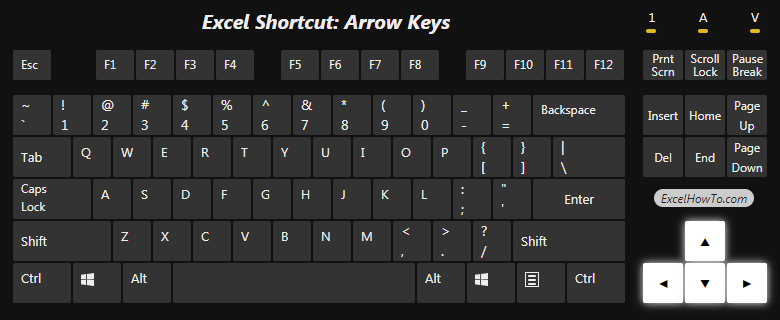
What's this keyborad shortcut to do?
- Move one cell up, down, left, or right in a worksheet.
- Scrolls left, right, up, or down one cell.
- Move selected shapes up, down, left, or right (0.5px each move).
- ← or → arrow key selects the tab to the left or right when the ribbon is selected. When a submenu is open or selected, these arrow keys switch between the main menu and the submenu. When a ribbon tab is selected, these keys navigate the tab buttons.
- ↓ or ↑ arrow key selects the next or previous command when a menu or submenu is open. When a ribbon tab is selected, these keys navigate up or down the tab group.
- In a dialog, arrow keys move between options in an open drop-down list, or between options in a group of options.
More:
- ↓ or Alt+↓ opens a selected drop-down list.
- Ctrl+Arrow key moves to the edge of the current data region in a worksheet.
- Shift+Arrow key extends the selection of cells by one cell.
- Ctrl+Shift+Arrow key extends the selection of cells to the last nonblank cell in the same column or row as the active cell, or if the next cell is blank, extends the selection to the next nonblank cell.
Windows shortcut
← → ↑ ↓
Mac shortcut
← → ↑ ↓
Notes:
- The shortcuts in this topic refer to the US keyboard layout. Keys for other layouts might not correspond exactly to the keys on a US keyboard.
- A plus sign (+) in a shortcut means that you need to press multiple keys at the same time. For example: Ctrl+Alt+Del means: Press and hold the Ctrl key and the Alt key and whilst holding them down, press and release the Del key.
- A comma sign (,) in a shortcut means that you need to press multiple keys in order. For example: Alt+H,H means: Press and hold the Alt key and whilst holding it down, press and release the H key, then press and release the H key.
- The left and right side key on the keyboard perform the same function. For example: Ctrl+A, you can press left Ctrl key or right Ctrl key.
Why You Should be Using Keyboard Shortcuts
- Efficiency: Many users find that using keyboard shortcuts for Excel helps them work more efficiently. In other words, using keyboard shortcuts could save you a lot of time, it's easier and gets your job done faster.
- Multitasking: Be a master at multitasking when needed. For example, when you are coding, writing reports or doing some research, it's common to end up juggling dozens of open tabs at once. Knowing the right shortcuts allows you to easily find the tab you need in less than a second.
- Health benefits: Cutting down on your mouse usage by using keyboard shortcuts can help reduce the risks of RSI (Repetitive Syndrome Injury). By alternating mouse and keyboard usage you can reduce the risks of R.S.I. and reduce the fatigue your wrists and fingers.
- Complementarity: You can combine the advantages of using the keyboard with those of using the mouse.
- Precision: When you have a job that requires precision it is advisable that you use the keyboard.